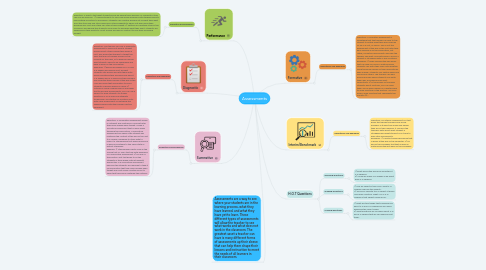
1. Performance
1.1. Definition and Examples
1.1.1. Definition: A way to test what students know by having them perform or complete a task. This can be done by: 1) Asking students to solve real world problems with tangible objects like creating a solution to a problem. Students can create a grocery list of what they want from the store and use store adds and a stores website to figure out how much their groceries will cost and if they can stay in their budget. 2) Setting up a pretend store in the classroom and having the students use money to purchase what they want. Students are showing you their ability to count money and add or subtract to find their remaining budget.
2. Diagnostic
2.1. Definition and Examples
2.1.1. Definition: The teacher can use A diagnostic assessment to figure out what a student knows about a topic before they begin a unit. This allows the teacher to target the skills that are not already known by the majority of the class, or to help her decide what students need to be challenged and have a grasp on the information. Examples: 1) Before we began our 2-D and 3-D shapes and figures unit, we split students into groups and had them write down everything they already knew about 2-D shapes and 3-D figures in their journals. We collected their journals at the end of the class and used that information to place students in groups based on need. 2) Instead of using a regular pencil and paper test to give pre-assessments, you can use a Kahoot to allow students to answer questions in a fun way and integrate technology. We started our fractions until with a pre-assessment of matching the shaded figures with the number fraction equivalent.
3. Summative
3.1. Definitions and Examples
3.1.1. Definition: A summative assessment shows if a student has mastered a concept after they have already been taught. Unlike a formative assessment that is given while teaching the information, a summative assessment will show if the student has mastered the content at the end of the unit. It is usually compared to other data to make it a standardized test where everyone is held accountable to the same state or district standards. Example: 1) Standardized Tests such as the STARR test of TAKS test are both examples of a summative assessment. 2) An end of the fraction-unit test given to all the students in third grade math at Bennett Elementary is a summative assessment because the students are required to take it on information that they have already been taught and must make a certain score to show that they have mastered the material.
4. Assessments are a way to see where your students are in the learning process, what they have learned, and what they have yet to learn. These different types of assessments will allow the teacher to see what works and what does not work in the classroom. The greatest asset a teacher can have is many different forms of assessments up their sleeve that can help them shape their lessons and instruction to meet the needs of all learners in their classroom.
5. Formative
5.1. Definitions and Examples
5.1.1. Definition: A formative assessment is something that the teacher can give to the student to gather what they have learned so far in a unit, or lesson. This is not the assessment at the end of the unit after they have learned all of the information, but rather, formative assessments will help the teacher see what concepts inside a lesson a student is struggling with or has mastered. Examples: 1) While learning the key words that can help you solve a math problem, students can write their own math problem using those key words on their desk with an expo marker. Students can switch desks and solve each other’s. The teacher can walk around and see which students can write them well, and which ones don’t understand. 2) In the middle of teaching students about fractions, you can have them use an expo marker on a white board to draw a picture of the fraction. “On your board, draw a picture that represents the fraction ¾ .”
6. Interim/Benchmark
6.1. Definitions and Examples
6.1.1. Definition: An interim assessment is a test given that shows teachers how much progress a student has made and where they are in their learning. It can give the teachers data about what student is struggling and what student is on track to pass later assessments. Examples: 1) A district wide benchmark that is given at the end of the semester. 2) An end of the six weeks test that is given in math during the last week of the six weeks.
7. H.O.T Questions
7.1. Opening Questions
7.1.1. 1) What would the world be like without 2-D shapes? 2) Could we make 3-D shapes if we didn’t have 2-D shapes?
7.2. Guiding Questions
7.2.1. 1) Pick an object in this room. What 2-D shapes make up this object? 2) Pick your favorite toy or object at home and draw a picture. What 2-D or 3-D shapes is that object made up of?
7.3. Closing Questions
7.3.1. 1) What are two things that surprised you about 2-D and 3-D shapes will you were exploring the room today? 2) What questions do you have about 2-D and 3-D shapes that we can explore next time?

